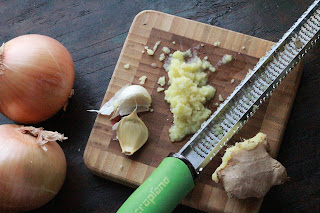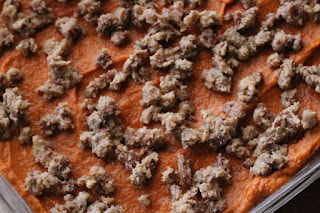The method for tempering chocolate is a good thing to know if you plan on dipping
truffles, or
caramels, making bark... in fact anywhere you would want to have a nice, solid piece, coat, or shell of chocolate that presents well. Maybe you want to have 65% chocolate for one reason or another and all you can find is 60% and 70%. It's possible to combine the two chocolates and create the desired percentage.
A good, tempered chocolate is smooth, has a slightly satiny sheen and snaps cleanly when broken. It does not bend, it snaps.
Once chocolate has melted it is out of temper, and it takes a little work to get it back into temper.
At a more molecular level, an in-temper chocolate has tightly packed and well organized fat crystals.
Alternatively, the crystals in melted chocolate are messy and disorganized. To bring a chocolate back into temper, organized crystals have to be reintroduced into the mess to stabilize it and whip everything back into shape, and then the chocolate needs to be carefully cooled. The solid chocolate added to the melted chocolate is called "seed" chocolate, and this technique is called seeding.
Chocolate should be solid at room temperature and melt at body temperature.
When in good temper and at a liquid point, the temperature is approximately 88 degrees F/31 degrees C (give or take a little depending on the cacao content- for example, milk chocolate is more stable and better behaved at a lower temperature, white even lower). Really, there's a small range for each type of chocolate, so it's not so extremely exact that it can't be done at home.
If a chocolate is not tempered, but has solidified, it will be softer in consistency, dull and matte, and the melting point will be lower than chocolate in temper.
In the shop, we have tempering machines that will keep melted chocolate rotating and at the desired temperature- very helpful when you have hundreds of one thing or another to dip.
However, there are times when we have to hand temper a smaller portion of chocolate and don't necessarily have time to get the machine fully up and running, such as when we foot a batch of ganache before cutting it into truffles. Hand tempering can be a good way to utilize time while waiting for a large amount of chocolate to come to temper in the tempering machine.
Now, if you want to work on something like this, it's important to start with a good chocolate that contains as few ingredients as possible. A five-ingredient dark chocolate should be good. Frankly, if there are extra ingredients, I'm of the opinion that there have been corners cut, the quality isn't very good, or someone is trying to hide something. I suppose it's possible that more than five is forgivable, but there's an area where things are not (wax, perhaps?).
(Chocolate at room temperature. On the left untempered after setting several minutes, and on the right tempered and completely set after less than a minute. The chocolate I used was bittersweet, so it was very dark and thick when in temper.)
Problems in chocolate tempering can exist, and some can be unsightly.
There are two kinds of bloom: fat bloom and sugar bloom.
Chances are good that practically everyone has opened a bar of chocolate to find that there are pale streaks and swirls on the surface- this is bloom.
The two types can look the same, but chocolate with fat bloom (cocoa butter has separated and made it's way to the surface) will retain it's smoothness, while sugar bloom can make chocolate grainy in texture. Bloom can indicate that chocolate may not have been tempered correctly or that it's not been stored properly. Perhaps it became too warm, melted slightly, and then cooled (perhaps someone carried it around in a warm hand and then put it down to let it solidify).
Because it melts at body temperature, it's not a great idea to carry chocolate around without a basket, bag, or box.
If chocolate has bloomed, it's not a complete loss. Bloomed chocolate can be re-melted and the crystals reorganized with the addition of good crystals.
Refrigeration of chocolate is permissible to help it set (and this is the only time it's allowed). Chocolate should be somewhat on it's way towards setting before spending time in the refrigerator. This means that after it has been put on parchment to set, it should remain at room temperature a few minutes, or until there's a visual cue that it seems to be "drying"and not completely shiny. After this point it can be refrigerated, but should be checked on every 5 minutes or so then stored at room temperature. It should not spend a long time in the refrigerator (overnight will prove much too long) because the cold can make chocolate crack, and there is also the chance of condensation forming on the exposed surface which can lead to solid but sticky chocolate since the sugars on the surface melt.
If you plan to dip something instead of slabbing out the chocolate, make sure that whatever you dip (strawberries, truffles...) is room temperature and dry.
To Hand Temper Chocolate:
First, start with a good chocolate. It's a good idea to have more chocolate than you think you will need.
Chop the chocolate relatively finely if you have a large piece (a serrated knife can do the job nicely), but if you have small or thin bits of chocolates such as buttons, those should work as they are.
Place about 2/3 of the chocolate in a bowl that offers plenty of extra space. Reserve the extra chocolate.
You have one of two choices, melt the chocolate in a bowl over a pan of simmering water (be very careful not to let any water come into contact with the chocolate), or the microwave over a low heat.
If in the microwave, heat the chocolate for about a minute or two, shake the bowl and melt a bit more if necessary. In either the microwave or over the stove, the chocolate does not need to be completely melted, but almost melted.
Remove the bowl from the microwave or over the pan of simmering water (dry the underside of the bowl with a towel if there is condensation), and stir the chocolate with a rubber spatula so it is completely smooth and well-combined.
Add a portion of the reserved, unmelted chocolate to the bowl of melted chocolate, stir and fold with the rubber spatula. Make sure all the chocolate in the bowl is included and keep the whole mass moving.
The point is to cool everything evenly and distribute the "good" crystals evenly throughout the mixture.
If the pieces of chocolate melt quickly, add more chocolate and continue stirring. With each successive addition of chocolate, add less. As the chocolate continues to cool, it will take longer for the bits of chocolate to melt. For dark chocolate, you're aiming for a temperature range of 88-90 degrees F/31-32 degrees C. Milk chocolate is in temper at 86-88 degrees F/31-30 degrees C. If you have a good digital thermometer, it can be a helpful tool in knowing for certain when you reach the appropriate temperature. To me, it always felt cool to the touch, and after you practice this a while, you may also be able to discern a textural difference in the chocolate.
If there are any unmelted bits of seed chocolate left in the bowl, remove them before using the chocolate as it can cause the tempered chocolate to bloom. Using a larger piece of chocolate near the end of the tempering process can make it easier to remove of the seed.
Use the chocolate as quickly as possible since it will begin to set!































































